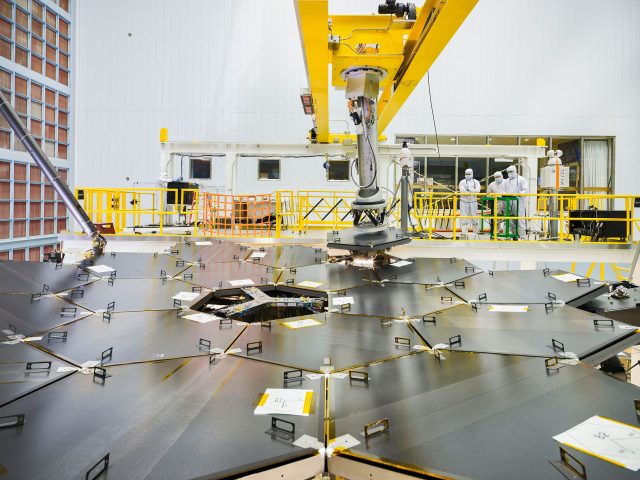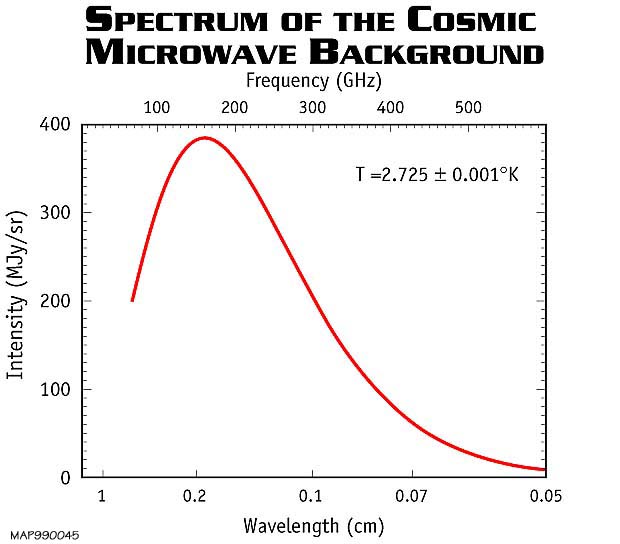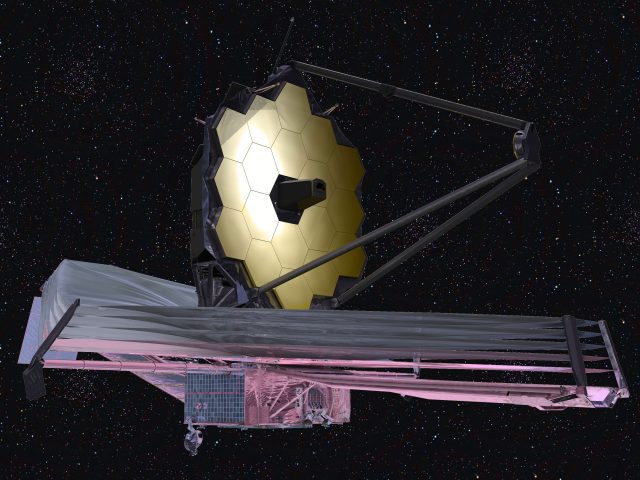
Since Galileo first discovered the moons of Jupiter and the phases of Venus, telescopes have gotten larger, more accurate, and more powerful. They're now installed all around the world from mountaintop observatories to suburban backyards. And over those 350 years, all of them have battled the same enemy: our Earth’s atmosphere.
The thin layer of nitrogen, oxygen, and carbon dioxide that makes life possible on our planet makes observation of everything beyond the planet maddeningly difficult. The atmosphere absorbs a great deal of the light outside the visible part of the spectrum, blocking or severely attenuating information about the cosmos. Its turbulent motions distort what does get through. It scatters our own light back down into our eyes and instruments, making the night more like a slightly darker day, washing out all but the brightest celestial objects in a haze of light pollution.

We can reduce this atmospheric obfuscation slightly by situating our observatories at high altitudes, far from population centers. But it is not enough. If only we could open a hole in our gaseous shroud and peer through it...
...but obviously, we can't. As such, researchers can do the next best thing. By 1990, we had years of experience putting machines into orbit around the Earth, outside of the troublesome atmosphere. Some of these machines were even telescopes of a sort, but they pointed toward the Earth in the service of intelligence agencies rather than science. Putting an astronomical telescope in space was a natural solution, and it followed directly—and, according to some, very directly—from the spy satellite program.
The Hubble Space Telescope was launched in that year, and it continues to return images even today. After a repair mission to correct its notorious optical defect, it has surpassed expectations, gifting us with inspiring images of galaxies, gas clouds, colorful nebulae, and planets in formation.

The Hubble takes advantage of its position 360 miles above the surface to gather information that would be absorbed by the atmosphere. It sees mainly in the visible part of the spectrum, extended slightly into the near infrared and ultraviolet. But there is much information about the Universe that is invisible even to the Hubble Space Telescope—and that's where NASA's much hyped, two-decades-in-the-making, $8.8 billion-plus James Webb Telescope comes in.
The Universe in infrared
Given its limitations, the Hubble is part of a system of four telescopes in space collectively known as NASA's Great Observatories Program. The other devices are Compton Gamma-Ray Observatory (now retired), the Chandra X-ray Observatory, and the Spitzer Space Telescope. The Spitzer sees in infrared light, the part of the electromagnetic spectrum commonly known as heat. The others observe the most energetic wavelengths of light.
We get information about our terrestrial environment in several forms via personal sensors that correspond to most of them: sound through our ears; pressure and temperature through our skin; gravity through the semicircular canals in our middle ears; small molecules through smell and taste receptors. Light is perceived through our eyes.
In space, no one can hear you scream, and there's precious little to taste or feel. We get some data from the flux of various particles, but most of what we know about the cosmos comes in the form of light. Some of this light falls in the visible part of the spectrum and forms the images brought to us by optical telescopes. These range in quality from nearly all amateur hardware to the orbiting Hubble.
But there are crucial insights hiding in other parts of the electromagnetic spectrum, as well. The collection of microwave data led to the analysis of the cosmic microwave background, verifying key elements of the Big Bang model. The search for forming planets and advanced extraterrestrial civilizations is carried out using radio astronomy.

The Compton Gamma-Ray Observatory made many unique observations, including the discovery of an antimatter fountain in the Milky Way. X-ray observation is a central part of astronomy, and the Chandra Observatory continues to advance this field. Past achievements include the discoveries of black holes, galactic winds, and enormous X-ray-producing jets hundreds of thousands of light years long.
The infrared part of the spectrum, just as the others, carries unique types of information. We’ve known for a long time that our Universe is expanding and that the farther away something is, the faster it is receding from us. The velocity of light in a vacuum is always the same, so its color is shifted if there is a relative velocity between us and its source. If we are moving closer together, the spectrum is shifted toward smaller wavelengths, a so-called blue shift. And if the source of light is moving away from us, its spectrum is shifted toward longer wavelengths: a red shift.
The farthest (and therefore, oldest) objects in the Universe are receding the fastest, so they have the largest red shift. In fact, their spectrum is shifted so far that the visible light (and some of the UV) emitted by the oldest stars and galaxies reaches us as infrared light.

In this essence, the Webb Telescope being built by NASA and its partners is a more direct successor to the Spitzer Telescope rather than the Hubble. In short, the Webb will open up a whole new world of infrared astronomy when it launches in 2018. The telescope will be able to capture images of the very first stars and galaxies, formed only 200 million years after the Big Bang.
The beautiful shapes of modern galaxies take billions of years to evolve, as the stars of which they are composed arrange themselves under the influence of their mutual gravitational interaction. That’s a bit too long for us to wait if we want to study the evolution of a single galaxy. However, just as our view of the Sun shows us our star as it was eight minutes ago, our views of distant galaxies show us how they looked billions of years in the past. This allows us to study them in all stages of growth, from the early proto-galaxies to the mature spirals and ellipses in our galactic neighborhood.
The James Webb Space Telescope will be a major advance over all previous infrared observatories. Its primary mirror will be 50 times the area of the Spitzer Space Telescope, and its infrared images will have eight times the resolution (about the same resolution in the near-infrared as the Hubble has in the visible spectrum). This will allow the device to capture images of the structure of the first galaxies in the Universe with unprecedented detail. The wavelengths that the Webb will image can not be seen at all from the surface of the Earth because of our atmosphere.
But being able to see like a boss in the infrared will tell us much more than what the earliest galaxies looked like.
Much of the information about stars and their births is obscured by interstellar dust, which absorbs visible light. The Webb Telescope will be able to see through this dust, which is relatively transparent to infrared light. This is particularly useful in studying the creation of stars, as young stars tend to form in dusty environments.
Infrared imaging will also provide information about the formation of planetary systems around these young stars, as the material from which planets are formed is heated by the star and glows in the infrared.
All this is made possible by the extreme infrared sensitivity of the new observatory. This was made vivid by John Mather, the physics Nobelist who is guiding the Webb Telescope toward completion. He joined the project in 1995 after accepting an invitation from NASA. And at the most recent AAAS meeting in Washington, DC, he astounded the audience by remarking that the telescope would be able to detect the heat generated by a bumblebee a quarter-million miles away—the distance from the Earth to the Moon.
If some form of life is eventually discovered on an exoplanet, the first sign will likely be the presence of signal molecules (such as methane and oxygen) in its atmosphere. One of the main purposes of the James Webb Telescope is the study of the composition of exoplanet atmospheres.
The telescope will carry sophisticated spectrometers to measure the characteristic absorption lines produced by the atmospheres of other worlds as they pass in front of their stars. This means that they will measure the intensity of the starlight at different wavelengths as the light passes through the exoplanet atmosphere, searching for dips in this graph where the light is absorbed by a chemical in the atmosphere. Most molecules of interest have key absorption features in the infrared part of the spectrum, so the Webb is well-suited for this mission.
reader comments
145